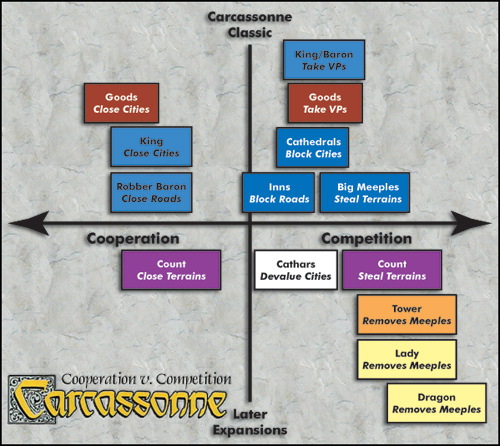Being a very successful game, Settlers of Catan has spawned numerous related games, both expansions and stand alone games. I am sure that many of the readers to this blog are tired of Settlers, yet have friends who still like to play. Luckily there are a ton of variations that should spice things up if you are getting bored but still have to play once in a while. Some variations introduce a few new concepts, some introduce a ton of new concepts. Most are good, a couple suck. This is a guide to help those of you who enjoy Settlers of Catan, but are looking to change things up a little.
This guide does not include the 2-player card game nor either of the “Catan Adventure” games, Candamir and Elasund.
Settlers of Catan: The grand daddy of all the Catan games was released 11 years ago and continues to be a best seller. Simple rules, lots of player interaction, different layout every time it is played, and the 60 to 90 minute playing time all serve to make Settlers of Catan a very popular boardgame.
I assume everyone reading this blog is familiar with Settlers of Catan. If you haven’t played it, buy it and play it tonight. I’ve been playing Settlers of Catan for about six years and it still frequently hits the table.
I seem to be in the minority in that I prefer the 3-player game to the 4-player game. The 4-player game gets crowded as soon as you start, and one player always seems to get screwed in the early stages. The player who doesn’t produce very much in the first few rounds and is unable to expand early will frequently get “squeezed out” of expansion opportunities. That player often has no place to expand his empire, except to a couple sparse hexes that produce very poorly, he just plods along with no chance to win, rolling the dice and gritting his teeth waiting for the game to end.
Barring extreme luck in the early stages of the game that scenario just doesn’t happen in the 3-player game. Three player games are usually pretty tight, right up to the end.
Ditto with the five and six player expansion. With the 5-6 player expansion the 5 player game is the better game in my opinion. The 6 player game will almost always have one unlucky player who has little chance to expand in the early stages of the game.
Seafarers of Catan: Seafarers is an expansion for basic Settlers of Catan. Gold fields are added, along with ships for shipping routes. Shipping routes are just roads on the water. Basically, if you like Settlers of Catan you will like Seafarers. It takes the basic system and adds just enough elements to keep the game fresh. Less than one minute of explanation is required to ease someone from the basic game to the Seafarers expansion.
Seafarers comes with a Scenario Book. The book is used to set up the board in a very specific way for each scenario. The number of victory points required to win vary for each scenario.
Cities and Knights of Catan: C&K is another expansion for the base game. It isn’t much of a stretch to say that if you like the basic game you will not like Cities and Knights, and vice versa. Cities and Knights changes basic game play in some very significant ways.
For starters, C&K lengthens the base game considerably. Expect playing time to double or even triple if your group plays basic Settlers quickly. Knights, event cards, city walls, buildings, the Metropolis, an extra dice, 3 different commodities and barbarians are all added to the game.
Every time a barbarian ship icon is rolled on the third dice the barbarians move on the barbarian track. Three of the six sides on the extra dice depict the barbarian ship. On their seventh move the barbarians attack. The strength of the barbarians is equal to the number of cities on Catan. To counter the barbarians the players must have as many or more active nights than there are barbarians. If they can’t match the strength of the barbarians, the weakest player has a city reduced to a settlement. If the players do defeat the barbarians the player who had the most knights gains victory points.
Knights can also be used to chase away the robber, but doing so flips them to their deactivated side (as does fighting barbarians). Knights must be activated in order to fight the barbarians. It costs one grain to activate a knight. It costs one wool and one ore to create a knight.
Every city wall that a player builds allows that player to increase his hand size by two cards. For example, a player with walls around two cities wouldn’t have to lose any cards if a “7” was rolled unless he had 12 cards in his hand.
Cities will often produce a commodity in addition to the normal resource when activated by the dice roll. Commodities are cloth, coins and paper. Cities on a pasture hex produce one wool and a cloth, cities on a mountain hex produce one ore and a coin, cities on a forest produce one wood and a ream of paper. Commodities are used to buy and upgrade buildings.
There are 3 colors of buildings. Remember the barbarian dice? The other three sides of the dice have a blue, green and yellow symbol. Each of those colors corresponds to a building. When a color is rolled it activates all the buildings of that color and may allow players to take an event card of that color. Event cards grant some advantage to the player.
When a player builds the fourth building in a color group he gains a Metropolis. A Metropolis is basically a city worth 4 victory points.
As you can see, Cities and Knights of Catan changes the base game significantly. For brevity I did not cover all the changes. I don’t care for all the changes myself. In my opinion Cities and Knights of Catan is just a bunch of clutter. In a nutshell, you take a very good game (Settlers of Catan), spend another $30 on an expansion and turn it in to an average game.
Settlers of Canaan: This variation of Settlers of Catan is a stand-alone game. Instead of the modular board that is different from game to game, the board is a map of the “Promised Land”, otherwise known as the area in and around present day Israel. Each hex is also numbered for its production value and that number will never change.
Gameplay is nearly identical to the original Settlers. A copper hex is added, which when activated gives the player(s) with an adjacent settlement a good of their choice. Players can also spend one brick and one ore to buy a “stone” to contribute to build the Temple. The player who has contributed the most stones to the Temple gains two victory points. The development deck has some different, interesting cards. Priests have replaced Soldiers although they serve the same function.
In order to contribute a stone to the Temple players must have a settlement at the south end of the board, otherwise they have to link by roads to another player’s settlement and pay that player an additional resource to contribute a stone to the Temple.
Settlers of Canaan has more hexes than standard Settlers and in my opinion is the superior 4-player game.
Settlers of Zarahemla: Settlers of Zarahemla is the only game in the Settlers series that I will discuss that I have not played. The big difference between this and basic Settlers is that the board is comprised of “strips” of hexes instead of individual land and water hexes. The strips are arranged into a hexagonal board, just as in the original game. A center strip, which is five hexes long, is placed in the center of the board, two strips four hexes in length are placed on either side of the center strip, etc.
The strips are placed into a larger frame designed to hold them in a hex pattern. Although there are ports in the game there are no port tiles, instead the ports are depicted along the edge of the frame and will always remain in their same relative positions. Unlike Settlers of Canaan, number chits are placed on the individual land hexes. Like Settlers of Canaan, players can contribute to the building of the Temple for victory points.
Just as Settlers of Canaan has its roots in the Old Testament, the theme of Settlers of Zarahemla is based upon the Book of Mormon. Apart from flavor text on some of the development cards there is little in either game that gives either game a religious feel. I liken the religious theme of both games to the “stated” theme of Ticket to Ride. The Ticket to Ride box states:
“The stakes: $1 million in a winner takes all competition. The objective: to see which of them can travel by rail to the most cities in North America – in just 7 days”.
Ticket to Ride? Well, maybe. It might sound nice, but traveling for 7 days for a million dollars has nothing to do with game play, so too is religion not a factor in either of these Settlers variants.
Settlers of the Stone Age: As with Settlers of Canaan and the Historical Scenarios, Settlers of the Stone Age is played on a set map with fixed numbers on each hex. There are only four land types/resources available in this version, in contrast to the usual 5 in the other versions. The four resources are stone, bones, hides and meat.
Players start with three camps and an explorer in Africa. Each camp functions in the same way a settlement does in other versions. Players must expand outward to the rest of the world from these humble beginnings. For a meat and a hide a player can build an explorer, for the cost of one meat he can move him. When an explorer is on an intersection he can be upgraded to a camp for the cost of one stone, hide, and bones.
Each player only has 5 camps at his disposal. If he builds a sixth camp he needs to move an existing camp. This is not usually much of a detriment to the player. When each new camp is established the player earns a victory point chit. As the game progresses Africa slowly turns into a desert. At least one of a player’s three starting camps is likely to be adjacent to multiple deserts even though the camps started out adjacent to productive land.
Near the edge of all the continents there are numerous chits placed face down. The first player to move an explorer to each chit gets to collect it. A few chits are worth victory points, other chits cause portions of Africa to become a desert. The player with the most exploration chits earns victory points, similar to the “Longest Road” in the basic game.
There are also 4 development tracks that each player can improve upon. One track allows explorers to travel further, another allows the movement of the Neanderthal or Saber Tooth Tiger (each the equivalent of a robber). Development on the clothing and shelter tracks is required before a player can move an explorer to various regions to collect exploration chits. For example, a player needs to be on the first or second level of both tracks to explore northern Europe, and on the third and fourth level of both tracks to explore Greenland and the South Pacific.
Advancing to the first level of each track costs a stone. The second level costs a bone. The third and fourth levels each cost a stone and bone. Only one player can reach the fifth level on each track, but the fifth level is worth victory points, it costs a hide, stone and bone to advance to the fifth level.
For some reason there tends to be little trading in this version of the game. Players are free to trade as always, but it just doesn’t seem to happen very often. The game is also longer than standard Settlers. In my opinion it lasts about 45 minutes longer than the fun it provides.
Starfarers of Catan: Settlers in space. How can you go wrong?
In Starfarers each player begins with three colonies, each colony adjacent to two planets. From there they need to send trade ships and colony ships to distant planets to establish more colonies and trade with alien races.
Again this version of Settlers is not played on a modular board, however each planet has a random, hidden production number. When a player is adjacent to a planet with a spaceship he can peek at the value of the planet and decide if he wants to found a colony there. When a colony is founded the numbers on the adjacent planets are revealed.
Some planets are “pirate planets”. Each pirate chit has a strength on it. Before a player can found a colony on a pirate planet he needs to “out-gun” the pirates. This simply mean that if the pirate planet is a “3” the player must have a spaceship with at least 3 guns before he can found a colony. Likewise some planets are “ice planets”. To found a colony on an ice planet the player needs to have more freight rings on his spaceship than the value of the ice planet.
Players can also found trade outposts with alien races. To do so he flies a trade ship to one of the four the alien race areas. The person with the most trade outposts with each alien race earns victory points. Each trade outpost also allows the player to choose a card which imparts some advantage to the holder.
Players have encounters in space. Each time a player moves his spaceships he “shakes” his mothership. The mothership has 4 different colored balls in it. Two of those balls appear, and based upon which two colors appear the player can move that many spaces. If a black ball appears the player has an encounter. An encounter card is drawn, and read. Encounters will state something like, “you encounter pirates who offer to trade with you, do you trade?” If you trade with the pirates they may steal from you, if you don’t trade with them they might attack you, there are many possibilities. If a battle ensues you “roll” against either the player to your left or right, the card will stipulate which. Again, you shake the mothership calculate value of the two balls that appear and add the guns you have added to your mothership.
Players can spend resources to buy guns, freight rings, or booster rockets to add to their mothership, or spend resources to found space colonies, trade posts and space ports.
Again, trading in this game seems to happen much less frequently than in basic Settlers. The game is much longer than standard Settlers. Starfarers is a 4+ hour game and only provides two hours worth of fun. Each colony is only adjacent to 2 resource hexes and no colony will ever produce two goods in the manner of a city in the base game. If the number of the planet is rolled and there is a colony on the planet it will produce only 1 good. Resources are collected very slowly, and unlike other versions of Settlers encounters can cause players to lose stuff that they purchased earlier.
So, how can you go wrong? Suffice it to say you can. This version lasts about 2 hours longer than the fun it provides.
Also note that the motherships are notorious for breaking.
Historical Scenarios I: As far as I know both Historical Scenarios are only available in German. An English translation is included with each.
The first Historical Scenario (as well as the second) is an expansion for the base game. Historical Scenario 1 includes both the Alexander the Great and the Cheops scenarios on a double sided board. The Cheops scenario stays pretty true to the original game. Again, Cheops can be explained to a person familiar with the base game in less than a minute. The Cheops scenario is based in ancient Egypt.
In Cheops if someone has a settlement on a port anyone can use that port if they can trace a road from their settlement to the port. It does cost one gold to do so. There are two hexes that produce gold when activated. Players can also contribute to the building of the Great Pyramid. The player who contributes the most stones to the pyramid gets victory points.
The Alexander scenario is not so simple to explain. Players represent generals in Alexander’s army. Players start with no settlements, no cities, no roads, no nothing on the board. Players do receive resources each turn, for a few rounds. Very soon those resources will run out and players must depend upon settlements and cities to earn resources.
Every turn Alexander moves one space on the map. Alexander simply follows the route markers on the board. When Alexander lands on a settlement it is auctioned to the highest bidder. Players bid a number of resource cards and must return them to the supply if they win. Once players have a settlement they can expand according to the normal rules of Catan.
Some of the spaces Alexander will land on will cause players to bid against each other to build bridges, monuments, do battle, and provide food. The player who wins the most auctions will become Alexander’s “First Advisor” and gains 4 victory points, there will also be a “Second Advisor” and “Third Advisor” who will each gain a lesser number of victory points.
Soldier cards can be played as normal to move the robber, but once they are played a player can use soldier cards as a resource card to bid when Alexander has to battle and only do battle.
Both of these scenarios should appeal to people who like the base game and are just looking to spice things up a little, especially the Cheops scenario. The Alexander version changes the game a little more.
Historical Scenario II: This expansion is also only available in German. Both scenarios in this expansion can be played with up to 6 players. Both scenarios are played on a set map. Again, the board is double sided.
In the Great Wall scenario each player is responsible for one section of the Great Wall of China. As the game progresses players can strengthen their portion of the wall and Huns are gradually added to “assembly areas” north of the Wall. When the number of Huns in an assembly area exceeds the strength of the wall in that section they pour over the wall into China.
The player who was responsible for the area of Wall breached takes negative victory points. Every area the Huns occupy produces nothing. Huns can be removed with soldier cards.
The robber in this version is a pirate. The pirate is placed on ocean hexes and blocks the use of ports until moved.
The Trojan War scenario can either be played with 4 or 6 players. The Trojan War scenario pits players against one another, but no one can be sure who is supporting whom. In this scenario players are secretly dealt a card at the beginning of the game. Each player will secretly support Troy or Mycenae in a war. Once per turn each player can contribute resources to the war. A player can secretly contribute 1, 2, or 3 resources to the war and earns one trade point chip for contributing.
When there are 10 resource cards (13 with 6 players) in the war area the war is resolved. The cards are shuffled so no one can be sure who contributed which resources. Ore and sheep count as support for Troy, wood and grain count as support for Mycenae, brick counts as nothing. The side that wins gets to move the war marker one space in their direction. The further the token gets to one side or the other the more victory points are awarded to the players supporting that side.
Trade point chips which are acquired by contributing to the war are required for the building of ships. Each ship a player builds imparts a trade advantage to the player or victory points.
Settlers of Nurnberg: Diceless Settlers. This is a stand alone game that (as far as I know) is only available in German. The game is played on a set map. The map depicts the usual Settlers hexes and roads to various European cities.
Yes, Settlers of Nurnberg is a diceless game. On his turn each player draws an event card. That card also has a number on it. Settlements produce based upon the number on the event card. The event on the card generally moves the robber or moves the pawn on the timeline. The game is over when the pawn reaches the end of the timeline if no player has yet reached 13 victory points.
Players can build settlements as in the original game as well as toll stations, workshops, city walls and towers. Toll stations are placed to help control trade routes to the various European cities. Workshops produce goods which are then sold to the various European cities for gold. Tolls must be payed to the player who controls the road to the city the goods are sold in.
Building city walls costs gold, but earns players “prestige points”. Prestige points can be used to gain “council cards” (similar to the longest road or largest army”). The player with the most prestige gains 4 victory points, the players with the second and third most prestige earn 3 and 2 points respectively.
Towers can be built for victory points.
I haven’t played this version enough to rate it, but the German text seems to be a significant hurdle to overcome, much more significant than in either of the Historical Scenario versions. I enjoyed Settlers of Nurnberg, but it was a struggle to get through.
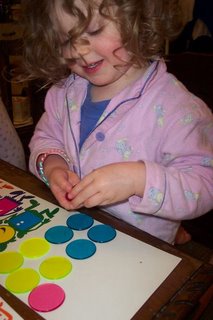
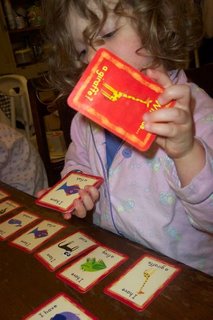 The second game we tried was "I have ..." - we picked this up for about $7.50 from our FLGS last Double Discount Day ... and I have to say, we overpaid. This is billed as a game for 5 year olds and up - it's a simple card game, where each card has a picture of an animal with the statement, "I have ..." on the front - and a picture of a DIFFERENT animal with the question, "Who has ...?" on the reverse.
The second game we tried was "I have ..." - we picked this up for about $7.50 from our FLGS last Double Discount Day ... and I have to say, we overpaid. This is billed as a game for 5 year olds and up - it's a simple card game, where each card has a picture of an animal with the statement, "I have ..." on the front - and a picture of a DIFFERENT animal with the question, "Who has ...?" on the reverse.  The third game we tried was more of a success from our perspective. Piggyback, or Rüsselbande, is a simple roll-and-move game with two things that make it stand out. The first is the pig meeples (peeples?) which you can use to make all sorts of shapes. The second is the fact that pigs can take rides on each other - if your pig lands on the same dot as another pig, it takes a ride on that pig's back until your next go.
The third game we tried was more of a success from our perspective. Piggyback, or Rüsselbande, is a simple roll-and-move game with two things that make it stand out. The first is the pig meeples (peeples?) which you can use to make all sorts of shapes. The second is the fact that pigs can take rides on each other - if your pig lands on the same dot as another pig, it takes a ride on that pig's back until your next go.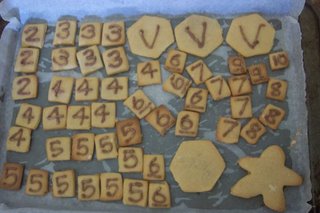 I realised on Monday morning that I didn't actually need a set of 10 nesting square cookie cutters to make the tiles, I could just cut squares of gingerbread - so another batch was baked, and we went for full playability.
I realised on Monday morning that I didn't actually need a set of 10 nesting square cookie cutters to make the tiles, I could just cut squares of gingerbread - so another batch was baked, and we went for full playability. As you can see, the '3' square fits nicely on this '2' temple hex ... it's when we add more tiles that it turns into a dexterity game...
As you can see, the '3' square fits nicely on this '2' temple hex ... it's when we add more tiles that it turns into a dexterity game...


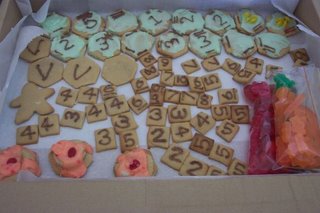
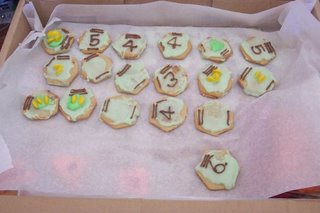

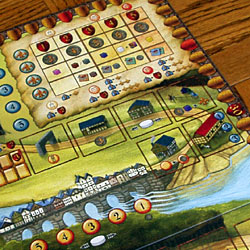 Caylus entered life on BGG with people claiming that early playtesters were artificially inflating the ratings. Several months later, on 2/18/06, two of the top threads at BGG concerned Caylus. One contained a scholary discussion of
Caylus entered life on BGG with people claiming that early playtesters were artificially inflating the ratings. Several months later, on 2/18/06, two of the top threads at BGG concerned Caylus. One contained a scholary discussion of 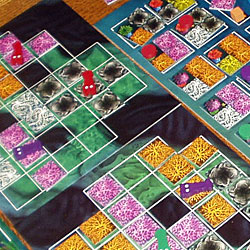 Reef Encounter was first released back in 2004, but in a limited 1000-copy run. It didn't hit the mass market until late 2005 with the Z-Man Games edition. That's a shame because I think it lost a lot of momentum in the meantime, and that it hasn't really received the attention it's deserved since the new release. Reef Encounter was my second Richard Breese game, and after being very disappointed with Keythedral I was very impressed with Reef Encounter.
Reef Encounter was first released back in 2004, but in a limited 1000-copy run. It didn't hit the mass market until late 2005 with the Z-Man Games edition. That's a shame because I think it lost a lot of momentum in the meantime, and that it hasn't really received the attention it's deserved since the new release. Reef Encounter was my second Richard Breese game, and after being very disappointed with Keythedral I was very impressed with Reef Encounter.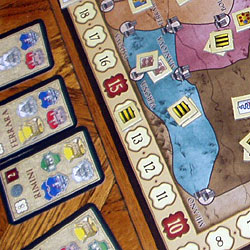 I've had a weird relationship with Italian games these last few years. The more I play games published by daVinci, Mind the Move, ZuGames, and Venice Connection, the more I think that Italian game designers have minds that work in weird ways. I have an increasingly long list of Italian games that just didn't click in my head when I read the rules, and which sometimes befuddled me with their multilayered strategies. It includes
I've had a weird relationship with Italian games these last few years. The more I play games published by daVinci, Mind the Move, ZuGames, and Venice Connection, the more I think that Italian game designers have minds that work in weird ways. I have an increasingly long list of Italian games that just didn't click in my head when I read the rules, and which sometimes befuddled me with their multilayered strategies. It includes 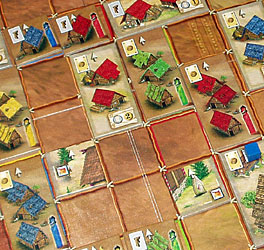 I think a lot of us were kind of expecting another Settlers before we played Elasund and were surprised that it was an original and innovative game, probably Teuber's best new work since ... I'm not sure what.
I think a lot of us were kind of expecting another Settlers before we played Elasund and were surprised that it was an original and innovative game, probably Teuber's best new work since ... I'm not sure what.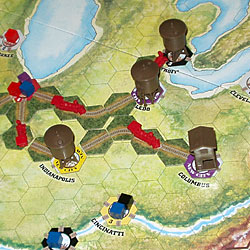 Railroad Tycoon is a fun boardgame that meets many of my criteria for creativity & strategy, but which I will almost never play. The main problem is length, because Railroad Tycoon takes 30-45 minutes to play per player, and the ideal player number is somewhere in the 4-6 range. If I could guarantee a 2-hour game every time, it'd be OK, but when it easily runs 3-4 hours, that's just more than my personal gaming can support.
Railroad Tycoon is a fun boardgame that meets many of my criteria for creativity & strategy, but which I will almost never play. The main problem is length, because Railroad Tycoon takes 30-45 minutes to play per player, and the ideal player number is somewhere in the 4-6 range. If I could guarantee a 2-hour game every time, it'd be OK, but when it easily runs 3-4 hours, that's just more than my personal gaming can support.









